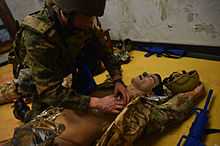Army Medical Service (Germany)
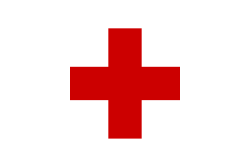
The Army Medical Service (German: Sanitätsdienst Heer or Sanitätsdienst des Heeres[1]) is a non-combat specialty branch of the German Army traditionally responsible for medical services within the army, and which traditionally has a humanitarian role during armed conflicts in accordance with international humanitarian law and specific responsibilities under the Geneva Conventions. It is entitled under international humanitarian law to use the red cross as a protective sign. Since 2002, most of its former responsibilities have been transferred to the Joint Medical Service.
History and organisation
.jpg)
The Army Medical Service has been a separate branch within the military since the German Empire, and both the Bundeswehr and its predecessors, the Wehrmacht and the Reichswehr, have had an Army Medical Service. However, since 2002, much of its traditional role has been taken over by the Joint Medical Service, although the Army Medical Service still exists as a much smaller organisation.
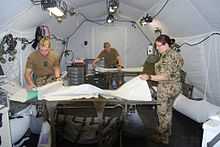
The Army Medical Service consists of military physicians, nurses, medics and other groups, and is traditionally responsible for providing medical humanitarian relief in armed conflicts, including caring for sick or wounded soldiers on the battlefield and operating first aid stations and field hospitals near the frontline, as well as organising transports of patients. Other responsibilities include occupational health services, medical disaster relief and international humanitarian missions in non-combat situations.
Members of the Medical Service are often informally and affectionately referred to as "Sanis" in German.[2]
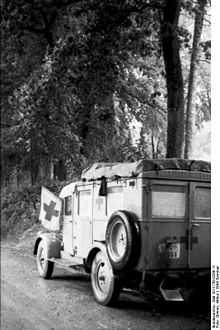
Status under international humanitarian law
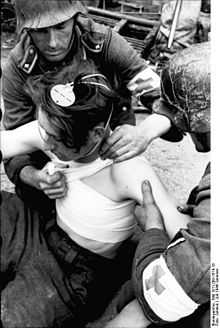
During armed conflicts as well as when engaging in other humanitarian missions, medical personnel identified as such are protected persons under international humanitarian law, and are entitled under the laws of war to carry out their work without being inhibited; they may not be attacked, harmed or taken as prisoners of war (attacking medical personnel is a war crime). The same protection extends to buildings and vehicles identified as part of the medical service. The Army Medical Service uses the red cross as a protective sign recognised under the laws of war; the sign is used on buildings and vehicles and may be worn on armbands as needed.[3] Personnel are issued identity cards identifying them as protected persons. Although personnel of the Army Medical Service are members of the armed forces and hold military ranks, they are considered non-combatants under international humanitarian law and thus enjoy protection and neutrality because of their humanitarian duties. This protection can be traced back to the First Geneva Convention of 1864.
Serving medical personnel identified as such are prohibited under the laws of war from taking part in combat action and their facilities or vehicles may not be used for military operations. However, medical personnel may be armed, usually with service pistols, for the purpose of self defense or the defense of patients.
Medical officer ranks of the Army Medical Service
Historical ranks are in italics.
| NATO code | Human Medicine | Dentistry | Pharmacy | Veterinary | Regular Army ranks | English translations |
|---|---|---|---|---|---|---|
| OR7 | Unterarzt | Unterarzt | Unterapotheker | Unterveterinär | Oberfähnrich | Officer Aspirant |
| OF-1b | Assistenzarzt | Assistenzarzt | Assistenzapotheker | Assistenzveterinär | Leutnant | Second Lieutenant |
| OF-1a | Oberarzt | Oberarzt | Oberapotheker | Oberveterinär | Oberleutnant | First Lieutenant |
| OF-2 | Stabsarzt | Stabsarzt | Stabsapotheker | Stabsveterinär | Hauptmann | Captain |
| OF-3 | Oberstabsarzt | Oberstabsarzt | Oberstabsapotheker | Oberstabsveterinär | Major | Major |
| OF-4 | Oberfeldarzt | Oberfeldarzt | Oberfeldapotheker | Oberfeldveterinär | Oberstleutnant | Lieutenant Colonel |
| OF-5 | Oberstarzt | Oberstarzt | Oberstapotheker | Oberstveterinär | Oberst | Colonel |
| OF-6 | Generalarzt | Generalarzt | Generalapotheker | – | Brigadegeneral | Brigadier General |
| OF-7 | Generalstabsarzt | – | – | – | Generalmajor | Major General |
| OF-8 | Generaloberstabsarzt | – | – | – | Generalleutnant | Lieutenant General |
Literature
- Alex Buchner, The German Army Medical Corps in World War II, Schiffer Publishing (Schiffer Military History), 1999, ISBN 0764306928, originally published in German as Der Sanitätsdienst des Heeres 1939–1945, Podzun-Pallas, 1995, ISBN 3790905542
- Hubert Fischer, Der deutsche Sanitätsdienst 1921–1945, 5 vols., Osnabrück, Biblio-Verlag, 1982–1988
- Rolf Clement, Paul Elmar Jöris, "Der Sanitätsdienst," in 50 Jahre Bundeswehr 1955–2005, pp. 198ff., Mittler, 2005
References
- ↑ Sanitätsdienst des Heeres, deutschesheer.de
- ↑ Schnelle Hilfe durch deutsche "Sanis", bundeswehr.de
- ↑ Protected persons, International Committee of the Red Cross
